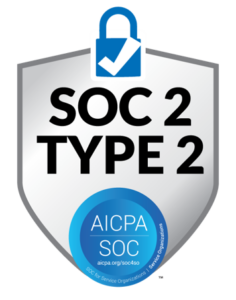Diversity, equity, and inclusion — you’ve heard these words, and their combining acronym, DEI, around the business world, if not at your own place of work. The past decade has seen companies imbuing their brands with DEI initiatives. Some of these include partnerships with community organizations to eliminate barriers for BIPOC and neurodiverse individuals, while other companies are focusing their efforts on improving the gender gap in leadership positions.
Unfortunately, DEI is also treated as a buzzword. Companies mandate diversity training for employees and call it a day on the DEI front. Think about your own workplace: where are DEI initiatives most prominent? Is there an emphasis on inclusive hiring practices, but company culture has yet to catch up in making daily interactions inclusive? Is there a diversity committee that provides educational resources on DEI, but management training isn’t on the table? Do the rainbow flags come out during Pride Month, and then get shoved in a drawer the rest of the year?
To have successful DEI initiatives, you not only need buy-in from all levels of the company, you also need everyone to be on the same page about DEI end-goals and what DEI means in your context.
Why is DEI important?
If you’re reading this, chances are you’re already aware of the benefits of DEI. From a societal perspective, diversity efforts in business are a way to tackle systemic racism and wider biases on a national level. Movements like Black Lives Matter and Pride have been calling for equality, equity, and justice for years, and the public is taking notice of how companies are responding.
If you need to be convinced of the “business benefits” of DEI, that’s been proven, too. Companies that prioritize diversity achieve better performance and are more profitable. This is particularly true for businesses that depend on idea generation. A diversity of perspectives leads a richer variety of proposals and better ideas.
Meanings of DEI — context matters
Diversity, equity, and inclusion don’t mean the same thing to every company. As you can see in Figure 1 below, the definitions provided by three sample organizations are very different from their dictionary definitions. They are business-oriented, and while some themes persist across them, they include different concepts. For example, Company A’s definition of equity emphasizes an ongoing process, while Company C’s definition takes a more “one and done” approach. Company B doesn’t include a definition for equity in its documentation at all.

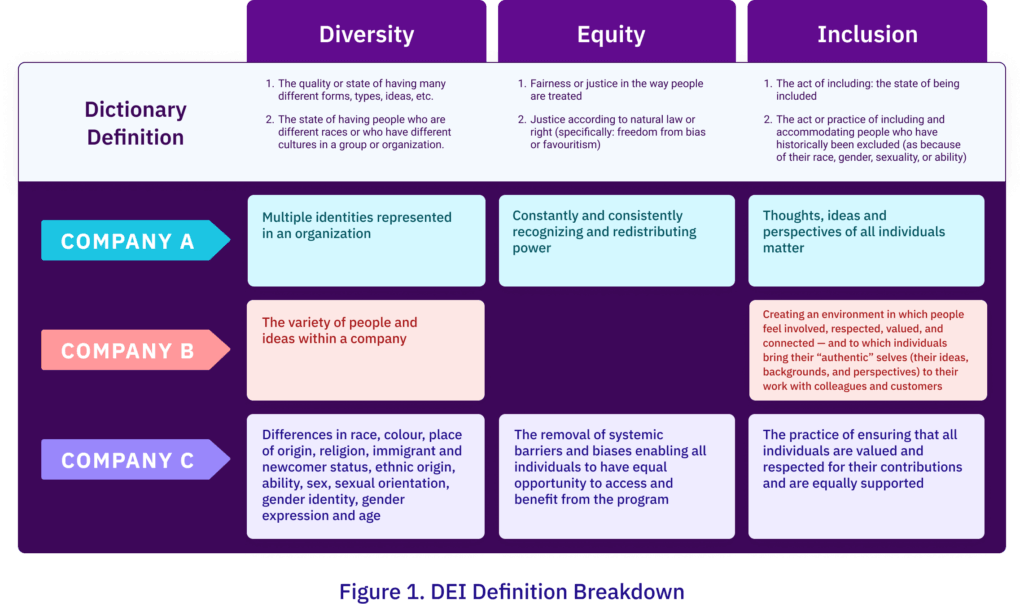
Having variety in how organizations define DEI strengthens the overall DEI movement. If everyone had the same approach, some aspects would be overlooked while others would be overrepresented. At the same time, companies need to be clear about how they’re defining DEI to create a cohesive approach.
Continuing the above example, someone using Company A’s definition of equity would focus on ensuring leadership positions within the company include diverse voices and perspectives. However, someone using Company C’s definition would focus more on access to the organization. Part of this difference also comes from the structure of the organization or program.
To discover the overarching characteristics of each concept, the above definitions and those from other companies were combined to see which terms are used the most and then illustrated in the word clouds below. The larger the word, the more it is used in the definitions.
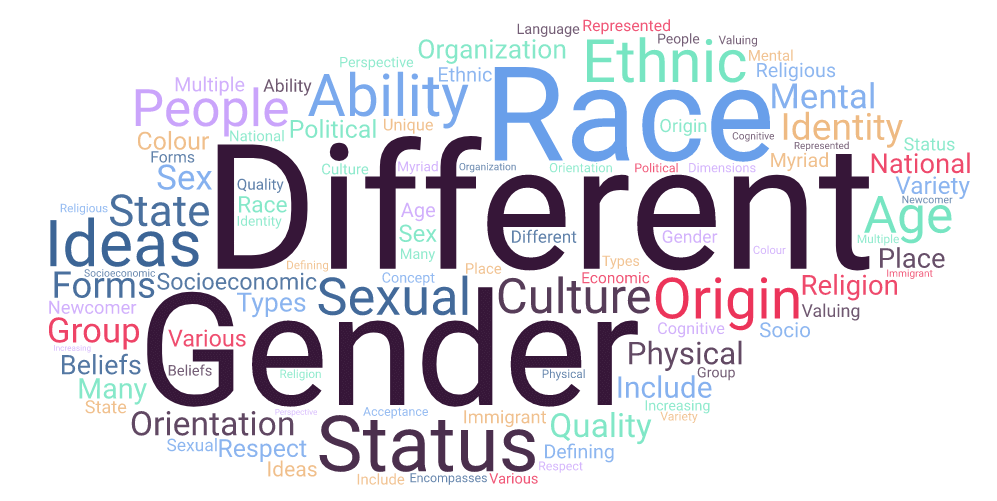
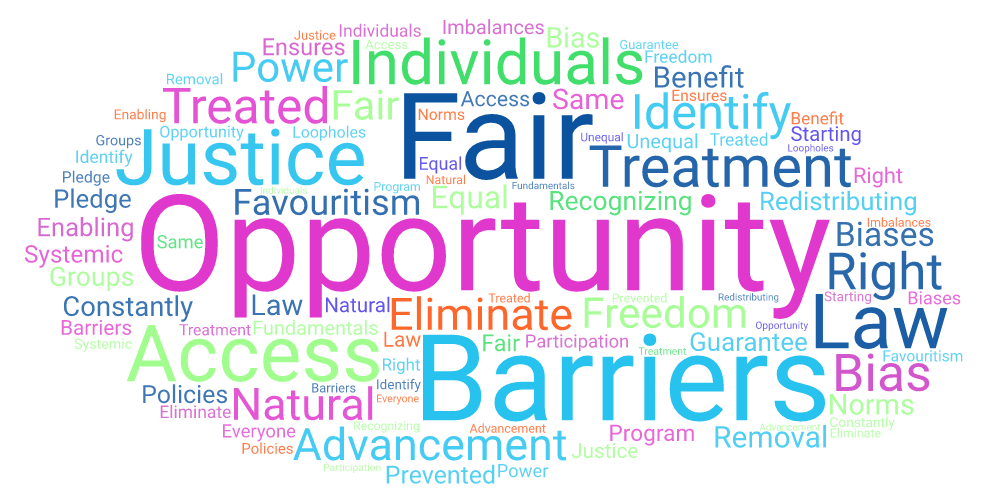
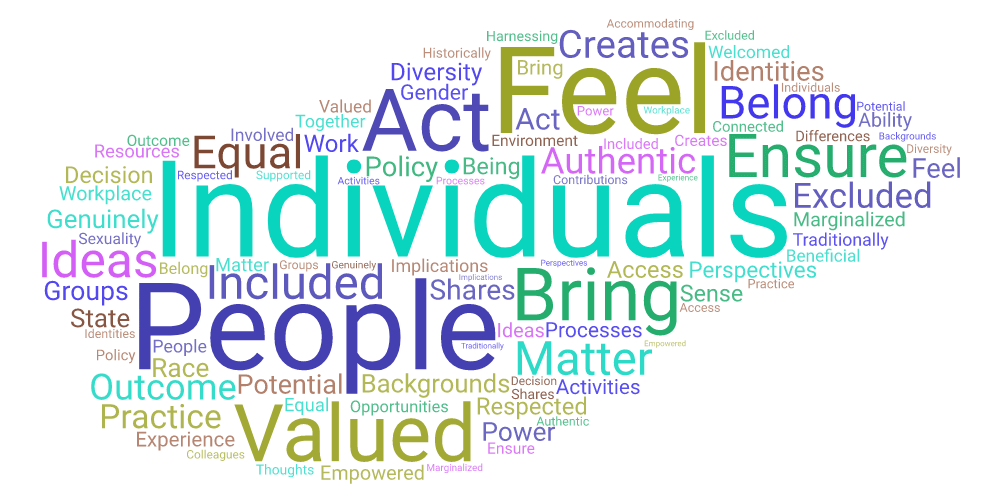
Looking at the most frequently used words, we can establish the following general definitions of the three main concepts within DEI:
- diversity: having people with differences, including gender, race, culture, sexual orientation, ability, and age, to provide varied perspectives and ideas
- equity: treating individuals fairly and eliminating barriers to access so everyone has the opportunity to contribute
- inclusion: ensuring people are not only included, but also feel valued for their individual ideas; creating a sense of belonging
Other ways to implement DEI at work
Figuring out how your company defines DEI is a great first step, but it’s only the first of many. Now, it’s time to relate those definitions to action. Maybe your definitions lend themselves well to a particular initiative. For example, if you’re defining equity as an ongoing process of power redistribution, it’s the perfect opportunity to introduce regular reviews of management positions and promotions through a DEI lens. If your definitions are more abstract, then it’s time to brainstorm how you can infuse DEI into new and existing policies and initiatives.
There are so many ways to implement DEI throughout your company, so use the following list for ideas and guidelines.
Create a dedicated DEI group.
Starting a diversity and inclusion committee might be a cliché first initiative, but it is important to have a dedicated group to brainstorm and plan DEI initiatives, measure impact, make connections in the community, and collect feedback. Consider appointing a Chief Diversity Officer to oversee the committee and broader DEI efforts. If you want to commit to DEI, make sure the group is a priority and not just another volunteer committee employees can list on their CVs.
Involve leadership.
Initiatives work best when there’s support from the top. Make sure leadership is involved with DEI efforts in some way, whether it’s through attending diversity committee meetings or having regular touchpoints with the Chief Diversity Officer. This shows the company is taking DEI seriously and will have a trickle-down effect when managers and employees see that leaders are buying into diversity, too.
Don’t stop at diverse hiring.
Having a diverse and inclusive hiring process is important for injecting diversity into your company, but make sure that diverse mindset follows new hires into the job. Having policies in place around inequality, discrimination, and harassment contributes to a safe working environment for all employees. Let employees know that racism and misogyny — even in the guise of “jokes” — won’t be tolerated, and make sure managers and HR understand these policies and what actions to take when incidents occur.
Promote internally.
In addition to putting diversity at the forefront of your hiring efforts, make sure that DEI is also considered in leadership and promotions. Are the best people overall being promoted to higher levels, or is it mostly those who fall in line with existing practices and ideas? Use the same anti-bias strategies for existing employees as you do for hiring and you’ll find that all levels of your company are aligning with DEI goals.
Consider points of view outside your own.
In self-evaluations, BIPOC and women are most likely to underrate their contributions. Remote work especially benefits employees with disabilities and those who are caregivers to children or ageing parents, often women. Be aware of which policies and practices act as barriers to different groups and judge their advantages and disadvantages accordingly.
Make use of AI in hiring.
We’ve written about this previously, and if you’re on our site you probably know that Knockri is all about achieving DEI goals using AI in your candidate selection process. Using our interview assessments strengthens company diversity by shortlisting the best candidates and taking the unconscious bias out of talent acquisition. For more information about Knockri and what we do, contact us using the form below; we’d love to chat with you!


